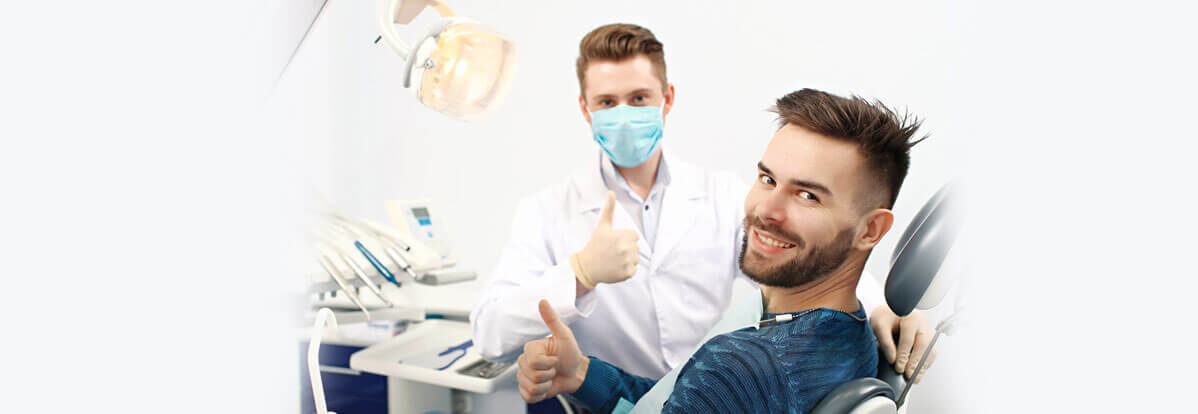Author: Developer
Everything You Need to Know About Invisalign Treatment: Before & After
October 1, 2019
Not many people are naturally blessed with straight teeth. However, dentistry can help them in achieving straight teeth with the help of orthodontic treatments. Still, many avoid getting the orthodontic treatment because of the embarrassment associated with wearing braces.
Invisalign has changed the orthodontic treatment scenario. Invisalign are basically clear aligners made of plastic which are not only more comfortable but also esthetically appealing. They are suitable for teenagers as well as adults as they are barely visible from a distance. Hence, they have become quite popular. If you are looking for getting Invisalign, let’s have a look at some details.
Preparing for Appointment
The procedure begins with consultation and evaluation of your dental condition. You can expect to fill the forms and answer the questions about medical and dental history. The dentist will also take an impression of the mouth for a better guidance. If Invisalign is not appropriate for you, he might suggest traditional braces.
If you have any questions regarding the treatment, write them down on a paper and don’t forget to ask the dentist. You must also discuss about the cost of treatment and the finance options that the clinic offers.
What to Expect During the Treatment
During the treatment for Invisalign in Pearland, TX, the dentist will offer you a set of aligners which you will have to wear in series. Each aligner needs to be worn for at least 2-3 weeks. The new set of aligner will put more pressure than previous one so that the teeth can move gradually to the desired position. The new aligners may cause little discomfort initially, but it will subside within a few days.
What Should be Done After the Invisalign Treatment
Just because you are done with the Invisalign treatment, it doesn’t mean the teeth will stop shifting.
- Get Retainers
Even after the treatment, the teeth have possibility to shift. Wearing a retainer will prevent them from shifting making sure that your teeth stay in the desired position. The dentist near you will give the type of retainer you need to wear. Removable and non-removable, both retainers are effective in keeping your teeth in place.
- Brushing and Flossing
Just like before and during the treatment, you need to maintain a good oral care routine by brushing and flossing regularly.
- Dental Appointments
It is important to see your dentist at regular intervals so that he/ she can evaluate your dental health after the treatment and identify any issues and treat them.
- Cost of Invisalign Treatment
According to the Pearland Dentist, you can expect the cost of Invisalign treatment to be on a little higher side than other traditional braces. The cost can be expected somewhere between 3500 to 8000 dollars. The dentist will be able to give the right Invisalign cost after inspecting your specific condition.
Benefits of Invisalign Aligners
- Almost Invisible
One of the best things about invisalign is that they are almost invisible. This makes them popular even among adults. Professionals can consider getting orthodontic treatment without Invisalign as they won’t cause embarrassment.
- Boosts Confidence
Apart from being one of the most comfortable options, they help in boosting the confidence of the patient. They can get rid of the painful wires and brackets and get a beautiful smile in a discreet manner. This boosts the confidence of the patient which usually goes for a toss because of crooked or misaligned teeth.
- Removable
Yet another significant benefit of Invisalign is that they are removable unlike the traditional braces which were removed only after the completion of treatment. One can remove them for a personal or professional meeting if the needed be.
- Better Dental Hygiene
As Invisalign is removable, one can practice good oral care. No wires or brackets come in way of brushing and flossing. You can remove the aligner and brush and floss as usual.
- No Food Restrictions
With traditional braces, there were a lot of food restrictions so that the wires and brackets don’t get damaged and food items don’t stick on the braces. With Invisalign, you can eat everything just like before. There are no food restrictions at all.
Tips from the Dentist for Maintaining Good Oral Health in Children
September 1, 2019
It has been observed that one out of 10 children already have a cavity at the age of 2. The statistics increase to 28% by the age of 3 and by the age of 5, almost 50% of the children suffer from the cavity. Many people believe that it is not important to treat cavity in baby teeth because they will fall out anyway. However, that is not true. You need to keep even the baby teeth healthy as decay in baby teeth can harm adult teeth.
It is important to teach your children the significance of maintaining good oral hygiene and following habits that are good for your dental health. Kids love all those things that can harm their dental health such as candies, gummies, chips, etc. and they love to avoid brushing their teeth. As parents, it is your responsibility to take care of your child’s dental health and make sure that they don’t end up compromising on their oral health. Let’s have a look at some suggestions from the dentist that will help your child in enjoying good oral health.
Brushing and Flossing
One of the first things you need to teach your children is brushing regularly. When the kids are young, you must brush their teeth and as they grow up you must supervise them while they brush their teeth. Your kids must brush their teeth twice a day for at least 2 minutes.
Ask them to hold the brush at 45-degree angle and make gentle circular stroked while brushing, says the kid’s dentist. You can make brushing a family ritual by brushing along with kids so that they can mimic you. You can take your child to the grocery store and allow them to choose a brush on their own so that they look forward to brushing.
You must also teach your child the importance of flossing and teach them the correct way, explains the pediatric dentist near you. You can also take your child to the pediatric dentist so that they can teach the right way of flossing to kids and the risk of injury can be avoided.
Say No to Sweets
According to the Pediatric Dentist in Pearland, TX, consuming excessive sugary items such as candies, chocolates, gummies, and juices are not good for oral health. The sugar is consumed by bacteria, which further produce acid and weaken the enamel leading to cavities. You can’t stop your kids from having them all together as it will result in them behaving fussy and oppose you. But you can certainly try to limit the consumption of these items by introducing your kids to healthier options.
Healthy Diet
A healthy diet not only helps your body but also your oral health, says the Pearland Pediatric Dentistry. A healthy diet consists of fresh vegetables and fruits along with drinking enough water and keeping yourself hydrated. You can have seasonal fruits and vegetables, especially carrots, apples, cucumbers, etc. They help in keeping your mouth clean and free from food debris and plaque.
Right Amount of Toothpaste
When your kids reach the age of 3, you can begin using a pea-size amount of fluoride toothpaste, which helps in preventing cavity. If your child doesn’t like the taste of toothpaste, you can try another flavor. Kids are too young to rinse and spit and they may swallow the toothpaste. Thus, teach them how to rinse and spit the toothpaste. Excessive exposure to fluoride toothpaste can cause white or brown spots on the child’s adult teeth.
Regular Dental Appointment
Apart from all the above-mentioned tips, it is important to take your child to the dentist right from a young age. The right time to see the dentist is when your child gets his/ her first teeth. When you take your child to the dentist from a young age, they will become familiar with the dentist, his clinic, and sitting in the dental chair. This will make them less anxious or scared of the dental appointments. The dentist will examine the oral health of your child and suggest any treatment if required for maintaining your child’s oral health.
Dental Implants are the Best Teeth Replacement Option
August 16, 2019
You can end up losing your teeth in spite of so many efforts. Teeth have gone missing for years and years. People are finding ways of replacing them. Today dental implants have revolutionized the process of new teeth that look, feel and function just like natural teeth. There are several dental implant options.
Dental implants
Implants are made from titanium which is very strong and in the shape of small screws. Titanium is a metal that is biocompatible and does not reject the body.
A dental implant is inserted into the jawbone. The nearby bone fuses and an implant is anchored firmly just as a natural tooth root. Implants function just like tooth roots that stimulate the bone to keep it strong and healthy.
An abutment is attached after the implant is firmly secured. The abutment help in connecting the implant with the restoration or replacement tooth. Restorations also include crowns, dental bridges and partial or full dentures. As per your need, one of these options is used to restore your ability to chew and smile.
Dental implant treatment lasts for a lifetime with proper care.
Dental Implant Options
There are many patients for dental implants. It is placed for the strength and thickness of the bone. A lot of pressure is applied to the bone while chewing, so there has to be a strong bone to anchor the implant. The professional uses imaging options to determine whether the implant is right for you.
There are 2 types of implants-
- Traditional
- Mini dental
Mini implants are recommended to those people whose bone is not suitable for full-sized implants.
The Implant Process
An oral surgeon is a specialist who carries out the dental implant process. They place the implants and restoration for healing.
The healing time required for mini dental implants is minimal. Healing time can be affected due to various health conditions such as diabetes and autoimmune disorders. Visit the dental clinic to discuss dental implants.
Find the dentist near to get a tooth replaced with dental implants.
How to Deal With Gum Disease Symptoms
August 1, 2019
Most people are aware of what they must do for keeping their smile healthy and the routine consists of brush, floss, and visiting the dentist in every 6 months for cleaning and examination. It’s the key for fighting tooth decay, but your dental health includes your gums too, as you need to take proper care of them just the same.
All of us have bacteria in our mouth, but when these cavity causing bacteria increase in number, they can irritate your gums and lead to infection, which is known as gum disease. Ignoring signs of gum disease can lead to tooth loss.
Signs to Look For
There are two stages of gum disease– gingivitis and periodontitis. While gingivitis is an early sign of gum disease, periodontitis is an advanced stage of gum disease. Gingivitis happens when plaque irritates your gums. However, in periodontitis the issues progress and begin to affect your teeth and breathe.
There are some common symptoms that you need to look out for so that you can get treatment in time.
- Swollen Gums are a sign that you are suffering from gum disease. Plaque and bacteria can irritate your gums and cause tenderness and swelling. The gums can also get discolored and look darker than normal.
- When the gum tissues get harmed, they begin to pull away from the teeth. If your teeth appear longer than before, the gums have probably moved.
- If your gums are infected, they will easily bleed when you brush and it is a sign of gum disease.
- Another sign of gum disease is the harmful bacteria, which can infect your gum tissues says dentist near me.
- When the infected and irritated gums pull away from teeth that begin to feel a little loose.
Gum Disease Treatment
If you are experiencing one or more of these symptoms, you need to see a dental professional in Pearland who can help in diagnosis and treatment of your underlying issue. If basic treatment doesn’t work, scaling and root planing may help in treating the advanced cases of gum disease.
Root Canal Treatment: The Real Cost
July 16, 2019
Root canal treatments are exceptionally advantageous. They are the best alternative to the traditional tooth extraction procedure. Thus, without any risk, they ensure that the problems of the patients including pain and sensitivity (in the affected area) are solved. Many people wrongly believe that this popular procedure comes at a high cost. While this may be true for some clinics, Pearly Whites of Pearland ensures affordable Cost and high-quality services. They are the Best Professional Dental Clinic for a Root Canal in Pearland. The Specialist Dentist Near you has explained the average cost of a root canal treatment, depending on a number of factors like:
- The tooth affected: the cost of the tooth depends on the tooth affected. This changes the complexity and requirements of the procedure considerably. The cost may differ from $300 to more than $2000.
- The most common area requiring root canal treatment are the molars. They cost the highest. This is because the average cost of the procedure is much higher since it requires more effort and time. Also, more material is required to fill the cavity of the pulp. Thus, the cost of treatment may range from $1000-1700.
- Moving outwards, the Bicuspids are considerably cheaper to treat. While some complexity ensures from the fact that they have two canals, the cost is still between $700-1500.
- Front teeth cost the least. The root canal treatment may be completed in less than $300-600.
- Dental clinic: some dental clinics and hospitals charge very high rates for the root canal treatment. The quality of services while being affordable is maintained by Specialist Dentist Near you like Pearly Whites of Pearland. They provide treatment at the right cost. Unlike other clinics, there is no exaggeration while using the latest technology and techniques. Moreover, owing to their years of experience, the dentists are experienced and perform the procedure safely and conveniently.
- Insurance: the cost of a root canal treatment also depends on the availability of insurance coverage. Medical insurance covers more than half the cost of the treatment. But a majority of people do not have insurance that covers orthodontic treatment.
Understanding Costs and Benefits of Dental Implants
July 14, 2019
Many people who are not yet 40 could be missing a tooth or two. This is not an uncommon phenomenon. When talking about dental implants, the natural position is that they may be too costly for you, and that keeps you from going forward with the procedure. This is a logical position, but the good news is many dental implant benefits make the cost seem less onerous. Affordable dental implants are a big part of prosthetic dentistry. When seeking out a dental implant, there are a lot of questions you may have, so it’s important that you understand the costs and benefits of dental implant surgery.
The Cost of Dental Implants
The price tag on dental implants may be off-putting to some people – the average range for dental implants is $3,000 – $4,500 depending on the needs of the patient including bone grafting, sinus lifting, etc. However, at many practices, there are affordable options, and furthermore, many practices provide options to break down payments to make things more affordable. Insurance may also pick up some of the cost, so check with your insurance carrier so that you can be sure that dental implants are an option for you.
The Benefits of Dental Implants
Dental implants have a serious price tag so it’s natural that you would want to know what you’re getting for your money. The answer is, in terms of dental prosthetics, dental implants are the best on the market. When comparing dental implants to bridges, the problem posed by bridges is that they need the strength of the adjacent teeth to be supported properly. Dental implants have no such need. The implant is a stand-alone tooth. It can chew and fills in your smile the same way a real tooth would. It’s strong and can stand up to the most rigorous brushing and flossing routines. Plus, it doesn’t rely on the strength of the adjacent teeth to stand up and work with the other healthy teeth in the mouth.
Why You Need To Get Your Dental Exam Done This Summer
July 1, 2019
With the onset of summer season many people plan to clean their house. It’s good to welcome the summer season with a cleaning session, but the cleaning should not be just confined to your house or belongings. It should extend to your oral health as well.
The preventive dental cleaning is quick and painless and will consist of both cleaning as well as examination. However, up to one third of people avoid making the dental visit to Pearland. Let’s explore some reasons why summer cleaning dental exams with Pearland dentist can prove to be beneficial:
- Early Diagnosis
Not every dental disease shows symptoms or cause pain. There are many conditions, which may be painless or show symptoms during the early stages. However, it is important to detect these issues early, as waiting for symptoms to appear can lead the dental issues to escalate further and make it more painful as well as expensive to treat.
- Screening Oral- Cancer
When you go for a regular dental exam, the dentist also screens your dental health for oral cancer. However, if the dentist diagnoses the dreadful disease early on, you can prevent it from progressing by going for a thorough cancer screening.
- Reduce the Plaque
When you visit the dentist near you, you will be given thorough teeth cleaning. During the procedure, the dentist will clean your stubborn and hidden plaque or tartar, which will help in preventing cavity, tooth decay, gum diseases, and other dental issues.
- Prevent Gum Disease From Advancing
If you are suffering from the early stages of gum disease, you may spot swollen gums, redness or bleeding quite easily. The dental exam near you will help in preventing the gum disease from escalating to Periodontitis, which can lead to bone or tooth loss.
- Prevents Cardiac Issues
Good oral care routine helps in reducing the inflammation and supports a healthy heart. Gum diseases have been linked to arterial diseases which make it important to ensure that your gum tissues are healthy. Healthy gums will prevent cardiac ailments.
Visits to dentist near you assures a good oral health.
Why You Should Deal with a Dental Emergency Quickly
June 24, 2019
A dental emergency will never come at a convenient time. When you bite into something, and there’s pain shooting through the tooth and the surrounding area, all you want to do is cry. We’ve all been there, and it’s miserable. Whether the emergency is caused by trauma or a festering problem that suddenly comes to life, you need to get to an emergency dentist Pearland, TX. At Pearly Whites of Pearland, one of our specialties is Pearland urgent dental care. We don’t want you to be feeling the effects of a bad situation longer than you have to.
What Constitutes a Dental Emergency?
There are several types of dental emergencies, but most can be lumped into one of two categories: sudden trauma or long-festering issues. Sudden trauma requires emergency dental care because there may be something that has happened to cause the loss of a tooth or the breaking of a tooth. When this happens, if you have the tooth, put it in a cold plastic bag in milk and bring it to the office. For the long-festering problems, usually, the solution is routine dental care like a root canal or crown. Sometimes old fillings break, and that’s a cause of a dental emergency. This can be quite painful as well, and fixing the filling is very routine.
How Does Emergency Care Work in Dentistry?
Emergency care in dentistry is the same as it would be for any other situation. When you feel a sudden onset of sharp pain, you must pick up the phone and call the dentist and let them know what you’re going through. Sometimes with a broken tooth, folks will go to the hospital if the dentist is not available. That’s ok as well. When it comes time for emergency care, the dentist will get you in as early as possible. They will take x-rays to assess the problem along with a physical examination of the affected area. Once that is complete, they’ll go forward with the procedure to get you immediate relief.
Conclusion
Dental emergencies are very serious and should never be blown off. Give us a call at Pearly Whites of Pearland if you have a dental emergency.
Foods You Should Eat for Healthier Teeth
September 15, 2017
Everyone has heard how bad sugar can be for your teeth, but what about the foods that can be beneficial for your dental health? Plenty of foods can help clean, strengthen, and whiten teeth; some can even help fight off bacteria and plaque in the mouth. Much like the rest of your body, healthy teeth, gums, and overall good oral health require nutritious foods. So what are some of these foods you should add to your diet for healthier teeth?
- Leafy Vegetables – Certain greens such as kale, broccoli, and spinach are rich in calcium, folate, and other key nutrients and minerals that can promote healthy teeth, gums and oral health.
- Nuts – Nuts can be another great food for optimal oral health; they contain calcium and phosphorus. Certain nuts can even fight against bacteria growth in the mouth.
- Cranberries – Fresh cranberries are high in polyphenols; eating them can help prevent plaque growth in the mouth!
- Strawberries – Strawberries are high in vitamin C, antioxidants, and even malic acid, which can be essential for oral health. Malic acid has even been shown to help whiten teeth!
- Carrots – Carrots contain a lot of different nutrients and minerals which can help strengthen and protect teeth, promoting optimal oral health.
- Apples – Not only do apples contain many essential nutrients and minerals that can help promote healthier teeth, but they are also fibrous and can clean your teeth while you eat them.
- Pears – Pears are also packed with many nutrients and minerals essential for healthy teeth. They may also help reduce acidity in the mouth.
- Shiitake Mushrooms – Shiitake Mushrooms contain a naturally occurring sugar called lentinan, which has been shown to disrupt the formation of plaque in the mouth.
These are the few suggestions of healthy fruits and vegetables by our Pearland Dentist that you can add to your diet to promote a healthier smile and mouth. There are many other fruits, vegetables, and other foods that are high in minerals and vitamins that can also be beneficial for your oral health. Avoiding foods high in sugars, carbs, and acidity can also help promote a healthier smile.
Does Sugar Really Cause Cavities?
August 26, 2017
Everyone grew up hearing about how eating too much candy will rot out all of your teeth, but how true is this story? Ultimately the answer is: Yes, however, it is a bit more complicated than that.
What Are Cavities?
Dental cavities, sometimes referred to as caries in their earliest stage, form when bacteria which live inside your mouth digest debris left over after eating. While sugar leftover in your mouth can promote decay and cavity formation, other foods such as bread, cookies, whole grains, fruits and even vegetables can also be a culprit!
Certain foods such as hard candy, raisins and even dry cereal are more prone to get stuck in the gaps, grooves and crevices of your teeth, making them harder to brush away. Leaving these debris in your mouth allow the bacteria to have a feast, producing acid along the way. Other foods such as fruits, vegetables and even yogurt are much less likely to get stuck in the mouth and wash away more easily with saliva. These kinds of foods are less likely to cause plaque buildup and decay.
Ultimately, the truth is, the bacteria that live inside your mouth enjoy every meal just as much as you do! As you begin to eat, the bacteria in your mouth also begin to digest debris, creating acid, which dissolves the enamel of your teeth. So what exactly can you do to prevent bacteria from creating acid and wreaking havoc in your mouth?
Reduce the Risk of Cavities
When consuming any food or beverage other than water, you are feeding the bacteria that live inside your mouth. To reduce the risk of these bacteria causing decay and cavities, we recommend brushing and flossing teeth regularly, and washing your meals down with water. Using a mouthwash after meals when you can’t brush can help rinse away the debris as well. Want to know more? Schedule a consultation with Pearly White of Pearland Today!
